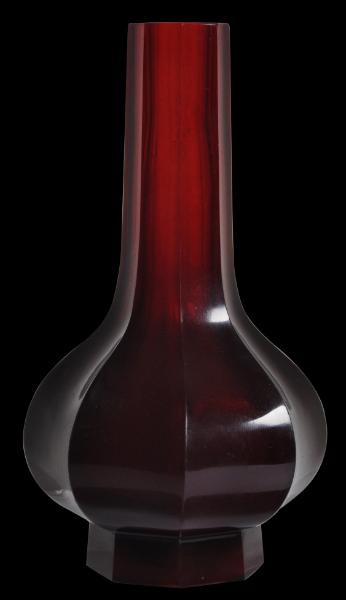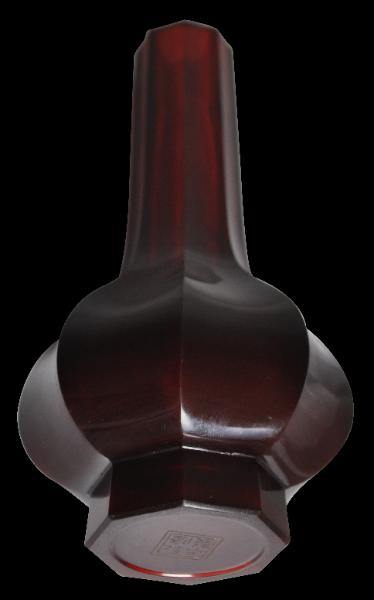Qianlong Chinese Red Glass Vase
Blood Red Glass Vase with Hexagonal Facets, Qianlong & Mark & Period
Beijing, China
1736-1795
height: 14.5cm
This Qianlong mark and period blood red glass vessel has been modelled with a compressed bulbous body, with curved, faceted sides, rising to a tall, straight neck, supported on a tall foot. Light swirling patterns have been worked into the deep blood red, most particularly about the base. The dark red achieved in this vase is a hallmark of Imperial glass making of the Qianlong era. Reds used into the nineteenth century became less rich and more pale.
The base is engraved with a four-character Qianlong mark within a double square. The mark is of the period and comparable with the marks on other examples of glass that are of the period (a near identical example is illustrated in Byrne Curtis (2004, p. 91).
A vase of similar proportions but in yellow was offered by Christie’s London in November 2008. Click
here
to see that example. Related examples, including a yellow glass vase of the exact proportions as the example here, are in the Geronimo Berenguer de los Reyes Jr Foundation Collection of Chinese Glass, and illustrated in Shangraw (1998). An almost identical red vase is in the Bristol Museum (N4532).
The Kangxi emperor (r. 1662-1722) played a crucial role in the development of high-quality glass production in Beijing. In 1683, the Emperor issued a personal decree establishing a Department of Imperial Artworks (the
Zaobanchu) to provide the Court and the Imperial Family with whatever furnishings and other items they would need in their personal lives. The Department also supplied the Court with items to be used as diplomatic gifts and the like. Glass production was not included in this initial decree but in 1696, another decree was issued to establish the Imperial Glasshouse within the Forbidden City. The Kangxi emperor insisted that the best glass-makers in China worked in the glasshouse on a seasonal basis. Imperial glassmaking received a further boost during the reign of the Qianlong emperor, the Kangxi emperor’s grandson (r. 1736-1795) – technical innovations and Imperial interest helped to usher in a brief golden age of Chinese glass making.
The vase here is without cracks or restoration. The rim of the mouth has two tiny chips and the foot also has a tiny chip – see the images below.
References
Byrne Curtis, E., Pure Brightness Shines Everywhere: The Glass of China, Ashgate, 2004.
Shangraw, C.F., ‘An array of choreographic colours: Later Chinese glass’,
Arts of Asia, January-February 1998.
Provenance
UK art market
Inventory no.: 2017
SOLD











Chip
Chip
Chip

